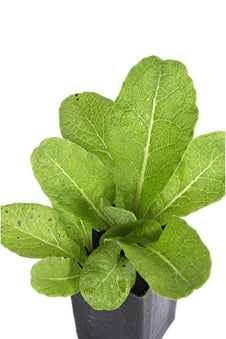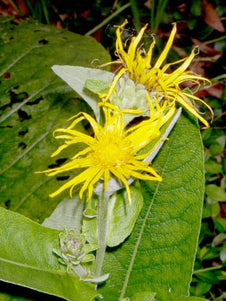



Elecampane
Elecampane

- In stock, ready to ship
- Inventory on the way

Usually available: August to April
Life cycle: Herbaceous Perennial
Height: 80cm - 2.4m
Position: Sun / part shade
Soil preference: Well drained
This is how we pack and send your Herb Plants to all states except TAS & WA
You will receive
- 1 Elecampane Herb Plant in a 50 X 75mm tube - General growing instructions
All of our Herb Plants are grown organically with certified organic potting mixes and fertilizers
Botanical Name: Inula helenium
Elecampane is a very tall and bristling perennial, with its grooved stems reaching from 80cm up to 2.4 meters high. The heavy and branching stem extends from a basal rosette of leaves resulting in a multi stemmed gathering of leaves together with clusters of yellow flower heads. The large, oval shaped leaves may reach up to 45cm long and 12 cm wide, but grow smaller as they rise up the stem. While the leaves at the base of the plant are large, soft and serrated those rising up the stem are wider and shorter. This can create quite a bushy appearance, with the rich green leaves often rolling downwards and the yellow flower heads appearing in summer to top off the display. The large flowers are yellow with its rays giving a ragged sunflower like appearance. They may grow to 5-10 cm across and each ray or petal has 3 distinctive notches at the end. The tuber-like roots are thick, branching and mucilaginous and have a distinctive floral aroma.
The native habitat of Elecampane is moist meadows and fields found in Great Britain, Central and Southern Europe and some Asian regions. It is naturalized in some areas of North America where conditions are similar to native habitats. This plant has many common names derived from a variety of sources. For example, Elecampane was once known as Elf Wort, or Elf Dock, and was considered sacred by the Ancient Celts. Other common names include Horse Heal, Scab Wort, Velvet Dock, Wild Sunflower, Enula, and Helenium. Elecampane goes by the botanical name of Inula helenium, although the variation of Enula campana is used by many.
Growing Conditions
Elecampane prefers full sun to part shade and has average water requirements. All soil types are tolerated but damp clay loam with acidic to neutral soil is ideal. Slightly moist soils, with good drainage, will result in better performance as this replicates the native habitat. During periods of extreme heat and dry conditions Elecampane will require extra water. Propagation may be via seed or by root cuttings.
Culinary Uses
The liqueur Absinthe was once flavoured by Elecampane and it was also used in combination with cinnamon and nutmeg to make a popular 19th century confection. It was once used to make throat lozenges and the Ancients were also known to make candied treats from the roots of this plant.
The roots have a warm bitter taste with a camphorous aroma and floral undertones.
Medicinal Uses
Elecampane contains inulin and helenin and was often used medicinally in ancient times as a tonic and stimulant. It remains popular in modern times with people interested in natural remedies. Herbalists recommend the mucilaginous roots from 2-3 year old plants be cut and dried, then used as an expectorant and for lung and sinus support, colds, flu and bronchitis. This plant is also used by herbalists as a digestive tonic, a worming agent, for regulating the menstrual cycle and for fluid retention. Its benefits as a relief for respiratory illnesses were also supported by its use as a digestive tonic which helped the recovery process.
There is some evidence for the value of Elecampane as a general internal and external antibacterial agent. Farmers and veterinarians were often able to use salves made from Elecampane to assist horses and livestock with skin irritations or wounds and also to treat horses with pulmonary illness. This is the source of common names like Scab Wort and Horse Heal.
Elecampane is not recommended for pregnant women.
All information provided on this website is for informational purposes only. Please seek professional advice before commencing any treatment.






